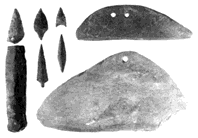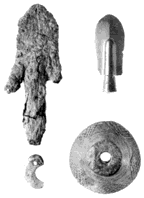ASUKA PREHISTORY AND ORIGINS OF THE HISTORICAL PERIOD
From the Stone Age to Beginning of the "Asuka Period"
|

Jomon Period :clay figure/
knife/
stone arrowheads/
earth digging tool
|
|
The Asuka of 3000 Years Ago (jomon Period)
At this time the Asuka region was covered by woodlands and moors, scene of the swift rounds of deer and wild boar. Humans were already settled in scattered locations. They made use of earthen vessels and stone tools, and lived by hunting wild animals and collecting fruits and berries.
|

Yayoi Period:stone spear/
stone arrowheads/
ishibocho (stone blade used for reaping) /
sing-bladed axe/
large ishibocho
|
|
The Asuka of 2000 Years Ago (Yayoi Period)
There were at this time in Asuka wet rice fields, and agricultural villages being.
With the course of time, iron blades were making their appearance, replacing implements of stone. Among the people, distinctions were beginning to be made between those who exercised control and those who were controlled.
|

Tumulus Period:iron arrowhead/
magatama ("curved jewel," probably having symbolic meaning ) /
bronze arrowhead /
spindle |
|
The Asuka of 1600 Years Ago (TumuluS Period)
In the Japanese islands of this time, members of the ruling house and of other powerful clans were vigorously pushing forward the unification of the country. As one means of displaying their power they built for themselves large tumulus graves (kofun), heaped over with high mounds of earth. Asuka at this time had not yet attained its later distinction as the country's administrative center, and tUmulus graves were not yet being built here. It is worth noting that at this time, or soon thereafter, newcomers arriving from the Korean peninsula were beginning to settle throughout the area of present-day Asuka Village (Asuka-mura) and in other nearby localities.
|
|
|
The Asuka of 1 400 YearS Ago (Beginning of the "Asuka Period")
Together with the acquisition of power and influence by the Soga clan, a wealthy family which exercised some degree of control over the immigrant settlers in the region, Asuka rapidly became the pivot of politics and' culture. The newly arrived Buddhist culture saw here its first bloom. Temples, imperial residences and the homes of other wealthy and influential families were built in close proximity to one another, and the Japanese nation-state of ancient times, with Asuka at its center, proceeded to take form.
|
SCOPE OF THE "ASUKA PERIOD"
|

Asuka panoramic photo |
|
As a periodization term, "Asuka Period" was first used around the year 1900 in reference to architectural and art history, and had as its original proponents Sekino Tadashi and Okakura Tenshin. Sekino designated the "Asuka Period" as that era most strongly influenced by Korean art, extending, in his estimation, from the reign of Empress Suiko (592~628) up to the time of the Taika Reform (645).Okakura considered the "Asuka Period" to extend, in its broadest sense, from the introduction of Buddhism --' he favored choice of the date 552 - up to the transfer of the capital to Heijo (Nara) in 710, during most of which time the dynastic residence was to be found in one or another part of the Asuka region. However, for purposes of an "exact year demarcation," he limited the period to the interval between the introduction of~Buddhism and the beginning of the reign of Emperor Tenji (667). Sekino conceived of the "Asuka Period" as that period leading up to what he termed the "Nara Period" (i.e., Hakuho and Tempyo Periods) characterized by influences from Tang China. while Okakura similarly conceived of the "Asuka Period,': in his narrower sense, as preceding what he termed the "Tempyo Period" (beginning in 667).
According to present usage, "Asuka Period," when referring broadly to Japanese history as a whole, designates the time from around the reign of Empress Suiko up to the transfer of the capital to Heijo, in approximation of. the broader sense of the term as used by Okakura. However, since use of the term by itself is in many cases liable to imprecision, it is more common to employ such terms as "the first half of the 7th century" or the name of a specific emperor or empress.
In the specific fields of art history, architecture and archaeology, however, the term "Asuka Period" is still commonly employed in the more narrow sense used by Sekino.
|
"ASUKA" AS A PLACE NAME
|
Today the term "Asuka" commonly refers to a broad area centering around present-day Asuka-mura, but including parts of Kashihara-shi,Sakurai-shi,Takatori-cho, etc. However, in the 7th and 8th centuries, "Asuka" was used primarily In reference to the area bounded on the west by the Asuka River, bounded on the north by Mount Kagu (Kaguyama) , and having its southern boundary in the vicinity of the Tachibanadera. The more northerly area of the Fujiwara capital and also the present-day districts of Toyura. Hinokuma, etc. (within Asuka-mura) seem not at that time to have been included in the designation "Asuka." In this museum,however, we employ "Asuka" in the first-mentioned, broader sense of the term.
In old documents, "Asuka" may be found written in various ways, with differing sets of Chinese characters. There is no single generally accepted explanation for the origin of writing "Asuka" with the two characters meaning. respectively, "to fly" and "bird." One hypothesis is that it derives from the stock epithet "of flying birds" ( tobu tori no) commonly prefixed to the place name "Asuka" in poetry. Another theory has it that these two characters were first applied as the result of the recorded appearance of what was alleged to be a particularly auspicious bird (shucho) in the year 685 (15th year of Emperor Tenmu's reign). Other writings of the same place name use combinations of either two or three characters whose phonetic values render, in apposition,the sequence asu-ka, or a-su-ka. (See Japanese text for examples.)
|
FROM THE AGE OF NEAR-AUTONOMOUS GOZOKU TO THE AGE OF RITSURYO CONTROLS
|
After the 4th and 5th centuries, the moving forces behind the country's politics at the "center" were a number of powerful and near-autonomous wealthy families (gozoku),
of which the most important, at least for ceremonial purposes, was the house of the ruling emperor. Around the middle of the 6th century, effective power was largely In the grip of two clans, the Mononobe and the Soga, but after 587, when the Mononobe Were purged from their position of shared oligarchy about the d~nastic house, administration tended to be monopolized by the Soga. and at the same time the Asuka region emerged more and more unequivocably as the country's administrative and cultural center.
Conditions in China came to be better known through the medium of envoys to the Sui and Tang capitals, and as Sui and Tang power began to extend into Korea, there appeared In Japan new movements which were opposed to this and other international and domestic trends, and which aimed at throwing off old structures and building a stronger and more durable Japanese state.
In 645 (first year of the Taika Reform), the Soga clan was brought down from its position of power by a coalition led by Nakatomi-no-Kamatari and Prince Naka-no-Oe, thus heralding the end of an age of domination by near-autonomous gozoku. Prince Naka-no-Oe (who later became Emperor Tenji, reigning 668 671)and his associates, while on the one hand pursuing armed struggles on the Korean peninsula against Tang and Silla (southeastern Korean) forces. sought on the other hand to build a new state which would make use of administrative systems adopted from China. The latter task was for the most part completed during the reigns of Tenmu (672 686) and his wife Jito (686 697).
The Chinese-inspired ritsuryo system of penal and administrative law was established as the country's fundamental legal code, and the general body of the populace, which had throughout the country lived under domination by near-autonomous gozoku, became subject to the control of the central administration, through the intermediary of offices for that purpose established In the capital region and in the outlying provinces. The Fujiwara capital (Fujiwara-kyo), completed for occupancy in 694 (the 8th year of Empress Jito's reign),may be said to have been at the same time intended as a sort of monument to commemorate what was thought of as the completion (nominally, at least) of a nation-state operating under the new regulations of the ritsuryo system.
|
|Asuka Period
|THE ASUKA PALACES
|ASUKA STONES
|ASUKA KOFUN|
|TAKAMATSUZUKA KOFUN
|THE ASUKA TEMPLES
|ASUKA AND THE MAN'YOSHU|
Copyright (c) 1995 ASUKA HISTORICAL MUSEUM All Rights Reserved.
Any request to kakiya@lint.ne.jp
Authoring: Yasuhito Kakiya
|